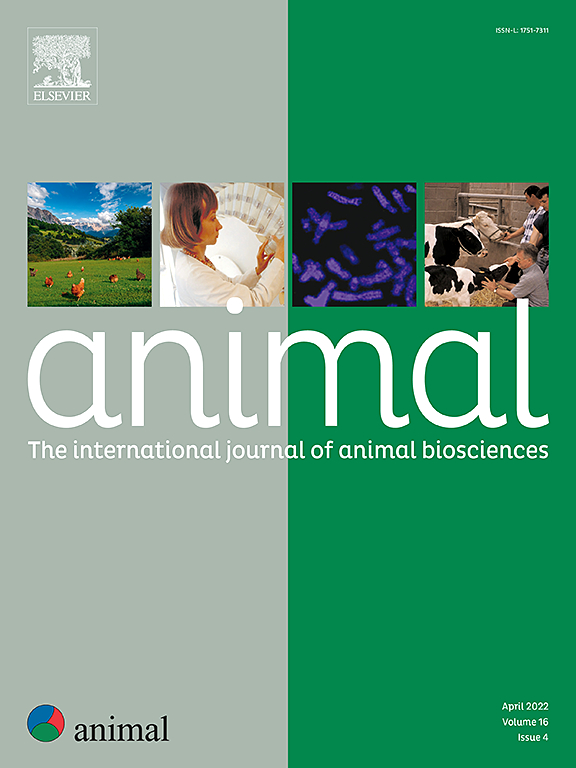综述:养殖策略、饲养和粪便管理对减少奶牛养殖中甲烷排放的影响:综述和未来道路
IF 4.2
2区 农林科学
Q1 AGRICULTURE, DAIRY & ANIMAL SCIENCE
引用次数: 0
摘要
反刍动物生产系统,特别是涉及牛的生产系统,在温室气体排放中起着重要作用,特别是因为它们排放的甲烷(CH4)的数量。在这里,我们描述并纳入了最相关的跨学科方法来减少奶牛养殖中的甲烷排放。我们研究了减少每日甲烷产量的遗传选择,包括目前在一些国家(如加拿大)纳入育种目标的关键方法(直接测量和中红外光谱预测)。我们还评估了饲养干预措施,如饲料消化率的提高和添加剂(单宁、藻类和3-硝基氧丙醇等特殊化合物)的使用,这些添加剂可能会减少瘤胃中甲烷的产生。最后,我们讨论了粪便管理策略(厌氧消化,缩短储存时间,降低温度)可以减少CH4的释放。通过结合这些方法,生产者可以在保持生产力的同时减少单位牛奶的甲烷排放量。然而,重要的挑战依然存在,例如在不简单地将排放转移到牛肉系统的情况下扩大养殖实践,以及验证膳食添加剂的长期影响。我们的结论是,在强有力的研究和政策激励的支持下,综合育种、饲养和粪便管理战略对于遏制奶牛CH4排放,同时确保全球牛奶生产的可持续发展至关重要。本文章由计算机程序翻译,如有差异,请以英文原文为准。
Review: Effect of breeding strategies, feeding and manure management, to mitigate methane emissions in dairy cattle farming: an overview and the road ahead
Ruminant production systems, in particular those involving cattle, play a substantial role in greenhouse gas emissions, particularly because of the amount of methane (CH4) that they eruct. Here, we describe and incorporate the most relevant interdisciplinary approaches to mitigating CH4 emissions in dairy cattle farming. We examine genetic selection for reduced daily CH4 production, including key methods (direct measurement and mid-infrared spectroscopy predictions) now being integrated into breeding goals in some countries (e.g., Canada). We also evaluate feeding interventions, such as forage digestibility improvements and the use of additives (tannins, algae, and specialised compounds like 3-nitrooxypropanol), which may reduce CH4 production in the rumen. Finally, we discuss manure management strategies (anaerobic digestion, reduced storage time, lower temperature) that can mitigate CH4 release. By combining these approaches, producers can potentially reduce CH4 emissions per unit of milk while maintaining productivity. However, important challenges persist — such as scaling up breeding practices without simply shifting emissions to beef systems, and verifying long-term impacts of dietary additives. We conclude that integrated breeding, feeding, and manure management strategies, supported by robust research and policy incentives, are essential for curbing dairy CH4 emissions while ensuring sustainable milk production worldwide.
求助全文
通过发布文献求助,成功后即可免费获取论文全文。
去求助
来源期刊

Animal
农林科学-奶制品与动物科学
CiteScore
7.50
自引率
2.80%
发文量
246
审稿时长
3 months
期刊介绍:
Editorial board
animal attracts the best research in animal biology and animal systems from across the spectrum of the agricultural, biomedical, and environmental sciences. It is the central element in an exciting collaboration between the British Society of Animal Science (BSAS), Institut National de la Recherche Agronomique (INRA) and the European Federation of Animal Science (EAAP) and represents a merging of three scientific journals: Animal Science; Animal Research; Reproduction, Nutrition, Development. animal publishes original cutting-edge research, ''hot'' topics and horizon-scanning reviews on animal-related aspects of the life sciences at the molecular, cellular, organ, whole animal and production system levels. The main subject areas include: breeding and genetics; nutrition; physiology and functional biology of systems; behaviour, health and welfare; farming systems, environmental impact and climate change; product quality, human health and well-being. Animal models and papers dealing with the integration of research between these topics and their impact on the environment and people are particularly welcome.
 求助内容:
求助内容: 应助结果提醒方式:
应助结果提醒方式:


